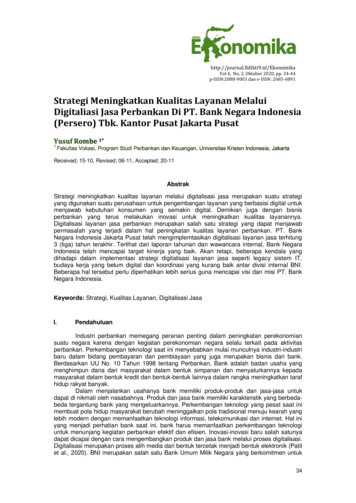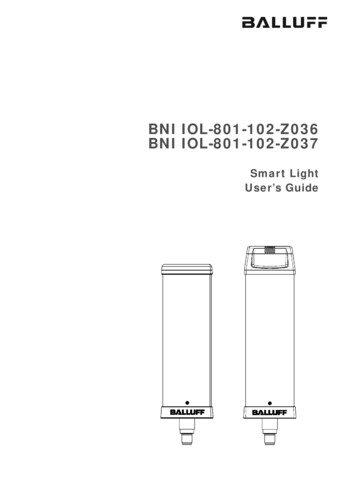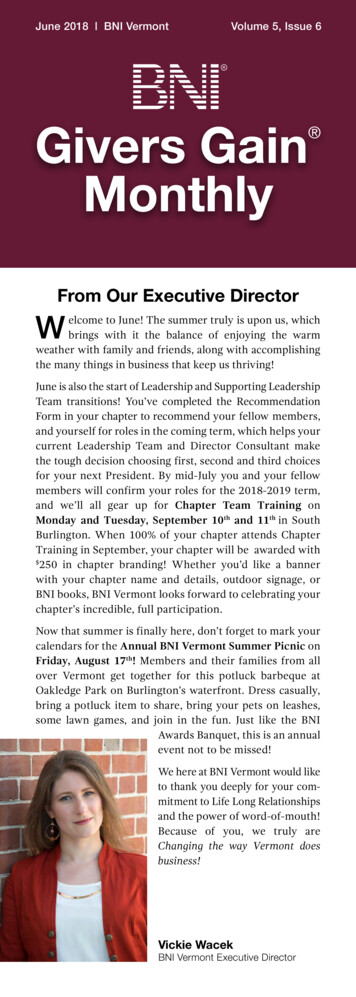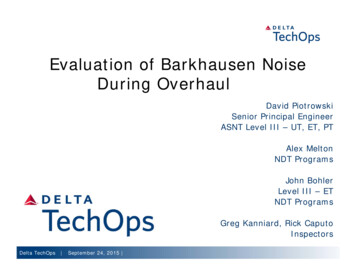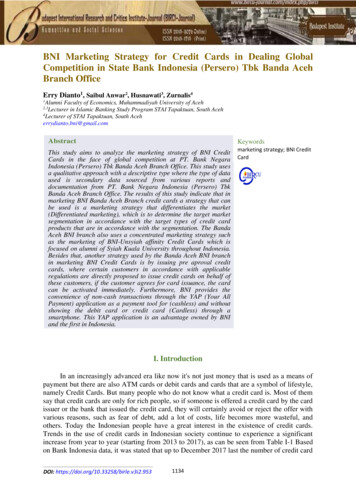
Transcription
BNI Marketing Strategy for Credit Cards in Dealing GlobalCompetition in State Bank Indonesia (Persero) Tbk Banda AcehBranch OfficeErry Dianto1, Saibul Anwar2, Husnawati3, Zurnalis41Alumni Faculty of Economics, Muhammadiyah University of AcehLecturer in Islamic Banking Study Program STAI Tapaktuan, South Aceh4Lecturer of STAI Tapaktuan, South s study aims to analyze the marketing strategy of BNI CreditCards in the face of global competition at PT. Bank NegaraIndonesia (Persero) Tbk Banda Aceh Branch Office. This study usesa qualitative approach with a descriptive type where the type of dataused is secondary data sourced from various reports anddocumentation from PT. Bank Negara Indonesia (Persero) TbkBanda Aceh Branch Office. The results of this study indicate that inmarketing BNI Banda Aceh Branch credit cards a strategy that canbe used is a marketing strategy that differentiates the market(Differentiated marketing), which is to determine the target marketsegmentation in accordance with the target types of credit cardproducts that are in accordance with the segmentation. The BandaAceh BNI branch also uses a concentrated marketing strategy suchas the marketing of BNI-Unsyiah affinity Credit Cards which isfocused on alumni of Syiah Kuala University throughout Indonesia.Besides that, another strategy used by the Banda Aceh BNI branchin marketing BNI Credit Cards is by issuing pre aproval creditcards, where certain customers in accordance with applicableregulations are directly proposed to issue credit cards on behalf ofthese customers, if the customer agrees for card issuance, the cardcan be activated immediately. Furthermore, BNI provides theconvenience of non-cash transactions through the YAP (Your AllPayment) application as a payment tool for (cashless) and withoutshowing the debit card or credit card (Cardless) through asmartphone. This YAP application is an advantage owned by BNIand the first in Indonesia.marketing strategy; BNI CreditCardI. IntroductionIn an increasingly advanced era like now it's not just money that is used as a means ofpayment but there are also ATM cards or debit cards and cards that are a symbol of lifestyle,namely Credit Cards. But many people who do not know what a credit card is. Most of themsay that credit cards are only for rich people, so if someone is offered a credit card by the cardissuer or the bank that issued the credit card, they will certainly avoid or reject the offer withvarious reasons, such as fear of debt, add a lot of costs, life becomes more wasteful, andothers. Today the Indonesian people have a great interest in the existence of credit cards.Trends in the use of credit cards in Indonesian society continue to experience a significantincrease from year to year (starting from 2013 to 2017), as can be seen from Table I-1 Basedon Bank Indonesia data, it was stated that up to December 2017 last the number of credit cardDOI: https://doi.org/10.33258/birle.v3i2.9531134
Budapest International Research and Critics Institute-Journal (BIRCI-Journal)Volume 3, No 2, May 2020, Page: 1134-1146e-ISSN: 2615-3076(Online), p-ISSN: rciemails: birci.journal@gmail.comholders in Indonesia reaches more than 17 million based on the number of cards, although thenumber of cards has decreased compared to 2016 due to policies in several Issuing Banks toremove card ownership from users who are no longer active or unable to fulfill obligationsaccording to the time that has passed determined. Card number, transaction volume andtransaction value as shown in the table below:Table 1. Credit Card Business Trends Based on Card Number, Transaction Volumeand Transaction Value in e(in 020.518275.270.000Source : bi.go.id, 2018The growth rate of the credit card business, which has significantly increased from yearto year, can show that people's purchasing power is also increasing. This has become apositive indicator for credit card business players that credit card growth will be moreprospective in the future.PT Bank Negara Indonesia (Persero) Tbk or commonly known by the public as BankBNI 46 is one of 23 banks in Indonesia that issues Credit Cards in which the Credit Cardbusiness in BNI is still the Market Leader with a total card ownership of 1.8 million withtransaction volume around Rp. 35 trillion at the end of 2017, while for 2018 BNI is targetingthe volume and value of Credit Card transactions to grow 2 digits or at least the same as themarket.The above is a challenge for BNI in the future so it is necessary to prepare anappropriate marketing strategy to introduce and build awareness among customers and thepublic about the existence of BNI Credit Card products. Moreover, Bank Indonesia haslaunched the National Non-Cash Movement (GNNT) since 2014 which aims to bringIndonesia into the era of people without money or Cashless Society. This is also evident bythe growing development of cashless payment instruments that use Android-basedapplications and other applications such as server-based electronic money, Tokopedia's CashShop, Shopee's Shopeepay, Grab's Grappay and Ust's Paytrend. Yusuf Mansur and otherAndroid-based applications that are developing, namely OVO.The Branch Office BNI Banda Aceh itself continues to boost its credit card marketingwhere it can be seen from the development of credit card marketing as of the last 4 years, canbe seen in the table below:1135
Table 2. Development of Credit Card Marketing PT Bank Negara Indonesia (Persero), TbkBanda Aceh Branch Office 2014-2017YearTargetApplicationEntryUnapproved CardApproved card%Achievement 634853233316247%201735045830914943%Source : CNM Medan, 2018From the table above, in the implementation of BNI Credit Card marketing shows thatthere was a decline in credit card acquisition compared to 2014 by 86% to 41% in 2015 and47% in 2016. In terms of the number of approved cards there was also a decrease from 2014by 171 cards dropped to 153 cards in 2015, 162 cards in 2016 and 149 Cards in 2017.Based on the description above, it can be seen that there is a decline in BNI Credit Cardacquisition performance due to the large number of unapproved card applications comparedto the number of approved cards, so this research was conducted at PT. Bank NegaraIndonesia Banda Aceh Branch Office to analyze the problem of BNI Credit Card marketingstrategies in facing global competition at PT. Bank Negara Indonesia Banda Aceh BranchOffice using descriptive analysis to determine the extent to which the marketing strategiesused have been effective in supporting the achievement of credit card business performance.II. Review of Literature2.1 Understanding of MarketingThe definition of marketing according to the American Marketing Association (AMA)as quoted by Kasali (2010: 53) is: Marketing is a process of planning and execution, startingfrom the conception stage, pricing, promotion, to the distribution of goods, ideas andservices, to make exchanges that satisfy the individual and his institutions.2.2 Understanding of Marketing StrategyChandra (2008: 93) that: "Marketing strategy is a plan that outlines the company'sexpectations of the impact of various marketing activities or programs on the demand forproducts or product lines in certain target markets". According to Andrews in Alma's book(2009: 199) that: "Marketing strategy is a pattern of decisions in companies that determineand express goals, intentions or goals that produce the main policy and plan for theachievement of objectives and detail the range of business that will be pursued by thecompany."Marketing communication can shape brand equity and improve promotionalperformance (Bogan 2014). The development of marketing communication that changes veryrapidly through advertising is not the only or the most important thing in establishing brandequity and driving sales, but can also be a mean which increases equity and drive salesthrough a mix of marketing communication. Moreover, expanding this communication canalso make the product or tourism object reach a wider market. Marketing communication mixis done to encourage the effectiveness and efficiency of marketing communication which1136
consists of eight main communication models, including advertising, sales promotion, eventsand experience, public relations, direct marketing, interactive marketing, word of mouthmarketing, and sales personnel (Philip Kotler in amin, 2019).Therefore, the determination of marketing strategies must be based on anenvironmental and internal analysis of the company through an analysis of the company'sstrengths and weaknesses, as well as an analysis of the opportunities and threats faced by thecompany from its environment. The process of selecting a marketing strategy requires carefulConsideration of a number of types of information:1. Product goals or objectivesProduct objectives should be used as guidelines in determining the basic types of strategiesneeded. For example, if the main purpose of a product is to increase sales volume ormarket share growth, then usually the main alternative considered is a selective demandstrategy that focuses on grabbing customers from competitors or expanding the marketbeing served.2. Market opportunitiesThe characteristics and magnitude of market opportunities must be clearly establishedbased on market analysis and market measurements. Market analysis provides informationabout who bought the form of the product (and who did not buy it), various situations ofproduct clothing (and also situations that did not use the product).3. Market successMarketing managers must understand the type of competitive advantage and the level ofmarketing expenditure needed to achieve market success. Through competition analysis,companies can understand who their competitors are, what level of intensity ofcompetition there is, and what advantages must be developed in order to competeselectively against direct brand competitors or indirect product class competitors.Environmental factors analyzed in the formulation of marketing strategies are the stateof the market or competition, technological development, socio-cultural and politicalconditions. The company's internal factors analyzed in the formulation of marketingstrategies are factors related to the implementation of company functions, which includefinance / expenditure, marketing, production and organization and human resources.2.3 Types of Marketing StrategiesAssauri (2008: 163) that in general marketing strategies, three types of marketingstrategies can be distinguished from companies, namely:1. Marketing strategies that do not discriminate the market (Undifferentiated marketing).With this strategy, the company considers the market as a whole, so the company onlypays attention to the needs of consumers in general. Therefore the company only producesand markets one type of product and tries to attract all buyers and prospective buyers witha marketing plan.2. Marketing strategies that differentiate the market (Differentiated marketing).With this strategy, companies only serve the needs of certain groups of consumers withcertain types of products. So companies or manufacturers produce and market differentproducts for each market segment. In other words, the company or manufacturer offers avariety of products and product mix, which are tailored to the needs and desires ofdifferent groups of consumers or buyers, with a separate marketing program that isexpected to achieve the highest level of sales in each of these market segments.3. Concentrated marketing strategy.With this strategy, the company specializes in marketing its products in several marketsegments, taking into account the limitations of the company's resources. In this case, the1137
producer company chooses a certain market segment and offers products that fit the needsand desires of the existing consumer groups in that market segment, which is certainlymore specific. This marketing strategy prioritizes all marketing efforts in one or severalspecific market segments. So the company focuses all activities will provide the greatestbenefits.2.4 Service Marketing MixIn marketing services known marketing mix strategy (marketing mix). According toTjiptono (2011: 39) The service marketing mix is a set of tools that marketers can use toshape the characteristics of services offered to customers which include products, prices,promotions, places, people, physical evidence, customer processes and services.2.5 Types of Service Marketing Mix1. Product2. Price3. Promotion4. Place5. People6. Process7. Physical Evidence2.6 Activities in the Marketing MixIn the competitive world of credit card business that is increasingly competitive todaythere are various kinds of marketing activities in order to achieve the targets set. Thesemarketing activities include Advertising, Sales Marketing, Publicity and Public Relations,Direct Marketing, Marketing Financing2.7 Selection of Marketing StrategiesBased on the study of literature on the factors that influence marketing strategies,interviews with representatives of company management and combined with the results ofobservations conducted by researchers, it can be seen the factors that influence thepreparation of marketing strategies namely Marketing Budget, Human Resources, MarketCharacteristics, characteristics product.2.8 Marketing Strategy ApproachThe marketing mix is strongly influenced by the selection of marketing strategiesadopted by the company. Two strategic approaches that can be applied are push strategy andpull strategy. The push strategy approach is aimed at those involved in distribution channels(such as agents, retailers, and wholesellers). This strategy is useful to include producers whouse salespeople and trade marketing to persuade intermediaries to take, market and sellproducts to end users. Whereas the pull strategy approach includes producers usingadvertising and consumer marketing to encourage end users to request the product fromintermediaries and thus encourage intermediaries to order the product from producers.1138
2.9 Bank DefenitionThe bank is simply defined as a financial institution whose business activities arecollecting funds from the public and channeling these funds back to the community andproviding other bank services. According to banking principal Law No.10 of 1998 quoted byIdroes (2008: 15) which regulates the main banking regulations in Indonesia define asfollows:"Banks are business entities that collect funds from the public in the form of depositsand distribute them to the public in the form of credit and or other forms in order to improvethe lives of many people."2.10 Credit cardBeginning in the early 1900s in the United States, several fueling companies (gasstations) and department stores have actually introduced a kind of shopping card that can beused by their consumers. But this card was issued by the company and its function waslimited to being a member card, as we often encountered, such as the Centro Club Card andso on. This system is known as "Charge-It" and was introduced by a banker named JohnBiggins from Flatbush National Bank of Brooklyn which aims to make it easier forconsumers (bank customers) to transact with shops or merchants who are also customers atthe bank.The next development is called the Diners Club Card. It started in 1949 accidentallywhen a businessman named Frank McNamara forgot his wallet after a dinner at a well-knownrestaurant. From here Frank McNamara debuted to find a cash or wallet replacement solutionthat might also often be experienced by restaurant consumers the other. In 1950, FrankMcNamara and his colleague, Ralph Schneider, returned to the restaurant using a uniquepayment card. This is the forerunner of the credit cards that we know today. It all started withDiners Club, which at that time was a type of "charge card". Charge Card, which means adelay card. It was only in 1951 when many Americans began to use it that plastic was used asa raw material in its current form. In 1958, American Express issued a credit card calledAMEX. Then followed by Bank of America issued a credit card, namely VISA. Furthermore,in the 1970s, the American government issued policy regulations regarding the rules and useof credit cards. Since then, credit card companies have expanded rapidly throughout theworld.2.11 Development of Credit Cards in IndonesiaThe development of the credit card business in Indonesia is now increasingly lively.This can be seen from the continuously increasing types of credit cards issued, the increasingnumber of customers, and the increasing number of outstanding credit cards and the value oftransactions in the last six years (2005-2010). If in 2005 the number of credit cards incirculation in Indonesia was recorded at 8.34 million cards with a transaction value of Rp.51.67 trillion, in 2009 the number of cards in circulation had reached 13.41 million cards witha transaction value of Rp. 273.14 trillion. Until the end of 2017, the number of credit cards incirculation in Indonesia has reached 17.22 million cards with a transaction value of Rp275.27 trillion. This is because credit cards are now increasingly popular as a cashreplacement tool and have even become part of the lifestyle of modern society in Indonesia.Besides being triggered by the development of people's lifestyles in big cities, the growth ofthe credit card business is also supported by a variety of interesting programs offered byissuing companies, following the increasingly varied tastes and needs of customers.1139
2.12 Definition of Global CompetitionBasically, global competition does not yet have a well-established meaning (standarddefinition). It means that global competition still has various meanings or it still depends onthe point of view of people in seeing it. Global competition can be seen from the economic,social, cultural aspects as well as from other aspects that cause interactions and competitionbetween people in the world.In general, global competition is defined as a form of world-level competition in whichevery country has the right to compete without being limited by territory. Global competitionis also often interpreted as a form of agreement between countries in the world to be able toactualize itself by removing the geographical, economic and cultural boundaries of society.Global competition in this study is defined as competition in marketing credit cardproducts with economic cooperation between countries carried out by the Indonesiangovernment with countries in Southeast Asia, namely ASEAN, where one of the economiccooperation is the AFTA or Asean Free Trade Area is a form of regional cooperation ASEANcountries to create a free trade area that only applies to ASEAN countries in order to increaseeconomic competitiveness for the sake of continued skyrocketing economic growth.III. Research Method3.1 Location and Research ObjectThis research uses a qualitative approach with a descriptive type where the type of dataused is secondary data sourced from various reports and documentation of PT. Bank NegaraIndonesia (Persero) Tbk Banda Aceh Branch Office which is made periodically which isclosely related to this research both data sourced from the Medan Card and Merchant andfrom the Card Business Division in Jakarta. This research was conducted from September 1,2017 to December 31, 2017 with the unit of analysis is PT. Bank Negara Indonesia (Persero)Tbk Banda Aceh Branch Office, while the research observation unit is the BNI Credit CardProduct.3.2 Technique of Collection DataTo obtain information and data needed in this writing, the authors use data collectiontechniques as follows:1. Documentation, namely data collection by studying company reports anddocumentation concerning the marketing activities of Credit Card products at PT. BankNegara Indonesia (Persero) Tbk Banda Aceh Branch Office.2. Interview is a data collection technique carried out by holding direct interviews withcompany leaders and a number of employees who have a direct relationship with theproblem that the authors put forward.3.3 Technique of Analysis DataThe analysis technique used is descriptive analysis which is a technique used byanalyzing and describing to describe the state of the object under study which is the center ofattention in research (Nazir, 2007: 16). Descriptive analysis techniques are used to helpidentify and expose the elements that are the focus of research. Sudjana and Ibrahim (2007:64) suggest that descriptive methods suggest descriptive analysis is used to describe aphenomenon, event, event at the time the research takes place. In other words, descriptiveanalysis method is used to describe and then describe the state of the object under study withthe things that are the center of attention. In this research, descriptive analysis is used to1140
explain the marketing strategy of PT Bank Negara Indonesia (Persero) Tbk, Banda AcehBranch Office in marketing Credit Card products in the face of global competition.IV. Discussion4.1 Analysis Development of BNI Credit Card Holder CustomersTo support the marketing activities of BNI Credit Card products, one of the visions tobe achieved is to increase the number of BNI Credit Card holders. An increase in the numberof customers will affect the marketing performance of BNI Credit Cards and will increasepromos held in Banda Aceh.BNI Banda Aceh Branch, is one of the companies engaged in banking services. Incarrying out its activities as a company engaged in banking, it is necessary to analyze thedevelopment of BNI Credit Card marketing performance. This is intended to evaluate thecustomer's developmentBased on the observations made by the author, it appears that the use of the abovemarketing channels was quite efficient and good, where in marketing BNI Credit Cards inaddition to using existing marketing personnel also involved all BNI Banda Aceh Branchemployees, each of whom played a role in finding prospective customers with goals asfollows:1. BNI Bank loyal customers, both individuals and companies that already havesavings products, savings, current accounts and deposits that are eligible to beoffered BNI Credit Card products.2. Agency or institution that has cooperated with BNI Banda Aceh Branch to channelemployee salary payment through BNI Payroll3. Individuals and Non-Customer companies, both those who trade at counter tellersand at Customer Service (walk in customers)4.2 BNI Credit Card Marketing StrategiesCurrent Credit Card Marketing Mix ActivityIn the increasingly competitive world of credit card business, Bank BNI has carried outvarious marketing activities in order to achieve the targets set. One of the marketing activitiescarried out by Bank BNI is advertising. Advertising is an important tool in relation to BankBNI's strategy to market BNI Credit Card products. The following is a series of advertisingactivities carried out by Bank BNI for marketing BNI Credit Cards, including:- Print Ad as an effort to use the press and print media for its credit card advertisingactivities, Bank BNI utilizes several national and local newspapers and magazines as aplace to place advertisements (print ad). So far the BNI Credit Card print ad has beenplaced in Garuda Indonesia's premium magazine, Colors. In addition to general /commercial print media, print ad is also placed in the company's internal magazines. Theprint ad in this magazine is very beneficial because it is in national and local print media(at certain events) in the back of the front page of the magazine and in full page size.- TVC (Television Commercial) Efforts to introduce and develop public awareness of BNICredit Cards are also taken by Bank BNI by using TVC at certain events. In addition, BNICredit Card advertisements are also often inserted at every BNI Bank on air event ontelevision. For example, during the drawing of BNI Taplus Fortune, a soccer match whereBNI sponsored one of the League 1 clubs, Bhayangkara FC. Aside from TVC ontelevision, Bank BNI also advertises BNI Credit Cards through ad lips on the radio. For1141
local radios BNI Banda Aceh Branch has collaborated with Radio Serambi FM and RadioThree FM, usually done at certain events and at launch new product.- The BNI Credit Card brochure is focused on highlighting the features of BNI Credit Cardfeatures such as cheap interest, personal accident insurance and free annual fees. Forspecifications, BNI Credit Card brochures measuring 30 x 21 cm with 180 gram mat papermaterial. Besides distributing brochures to all Branch Offices, they are also distributedduring direct selling, gathering and exhibition activities. Banners are placed one pieceeach in each Branch Office with targets, namely customers and non-customers of eachBranch Office. Banners are expected to be the initial media to build customer awarenessfrom each branch office on BNI Credit Cards.- Paper Bags are distributed both to BNI Credit Card holders and prospective card holders atBNI Credit Card marketing events such as gathering and exhibition activities.BNI Credit Card promos currently underway include:a. Giordano (All Outlet), 20% discount for regular products until May 12, 2019.b. Nike (All Outlet), 10% discount for regular products with a minimum transaction of Rp. 1million, Installment 0% 3 Months (minimum transaction of IDR 2 million) and 6 months(minimum transaction of IDR. 4 million, valid until May 12, 2019.c. Tiberland (Center Point), 10% discount for regular products with a minimum transactionof Rp. 500 thousand, Installment 0% 3 Months (minimum transaction of Rp. 4 million)and 6 months (minimum transaction of Rp. 6 million) valid until 12 May 2019.In addition to the above-mentioned promos, there are still many promos at star hotels,economical shopping promos at certain supermarkets and splashy promos both local andnational.4.3 Selection of Marketing StrategiesSTP (Segmentation, Targeting and Positioning)A clear and effective STP is one of the success factors of the marketing strategyimplemented by BNI's Banda Aceh Branch in marketing credit cards. BNI Banda Aceh inmarketing credit cards has segmented the market according to the type of credit card ownedand has determined the target market according to the type of credit card, among others, asfollows:- For regular types of credit cards namely BNI Visa / MasterCard Silver and Gold, thetargets are the Civil Servants who are in the environment of the Government of Aceh,housewives who have deposits in BNI with certain fund holders, Teachers / PublicLecturers.- For the type of affinity cards that have collaborated with BNI, namely the BNI Unsyiahaffinity card, the target market is Syiah Kuala University alumni who wish to contribute tothe campus using the BNI Unsyiah Credit Card will be set aside for the benefit of thecampus in accordance with applicable regulations agreed between BNI and Syiah KualaUniversity, Banda Aceh.- For premium card types, the main target is young entrepreneurs who are energetic andwant to look more brilliant using BNI credit cards. Besides that, it is also intended for civilservants or private parties who are eligible to be given a premium card.- For the type of BNI Credit Card, the Corporate Card is a BNI credit card given toemployees with a certain level or position of a company that can be used as a means ofpayment or transactions related to company activities, currently there are severalgovernment and private agencies that have collaborated with BNI to use the BNI1142
Corporate Card for expenses such as airline tickets in cooperation with Garuda Indonesiausing the BNI Corporate Card.After determining the segmentation and target market as mentioned above, thePositioning that Bank BNI is trying to build for BNI Credit Cards is a favorite credit cardwhere there are many choices of cards according to segmentation.4.4 CompetitionThere are several banks that become BNI's main competitors in marketing credit cardsin Banda Aceh, namely BCA, Mandiri, BRI and CIMB Niaga. The level of competition inmarketing credit cards is very fierce in Banda Aceh where many competing banks currentlyprovide programs and promos at merchants to pamper existing credit card holders and toattract public interest in using credit cards. This looks like a promo done at Ace HardwareSuzuya Mall where the promo applies to members and users of BCA, Mandiri, CIMB Niaga,BRI and BNI bank credit cards not wanting to miss participating in the promo. Not only atAce Hardware, the joint promo was also held at Informa Banda Aceh. So that the competitionof the five banks is very visible in marketing credit cards.4.5 Implications of Research ResultsAfter doing all the research on credit card marketing strategies at PT Bank NegaraIndonesia (Persero) Tbk, Banda Aceh Branch Office, the authors obtain the implications fromthe company for the development of BNI credit card marketing. These implications cover avariety of ways undertaken or taken by BNI Banda Aceh Branch, including:a) In marketing credit cards BNI Banda Aceh Branch uses a marketing strategy thatdifferentiates the market (Differentiated marketing) where in marketing credit cards,BNI Banda Aceh Branch determines the market segmentation to be targeted accordingto the target type of credit card product that is in accordance with the segmentation. Inaddition to the above strategies BNI Banda Aceh Branch in marketing credit cards alsouses concentrated marketing strategies such as marketing of BNI-Unsyiah affinityCredit Cards focused on alumni of Shia Kuala universities throughout Indonesia.b)Providing convenienc
2,3Lecturer in Islamic Banking Study Program STAI Tapaktuan, South Aceh 4Lecturer of STAI Tapaktuan, South Aceh errydianto.bni@gmail.com I. Introduction In an increasingly advanced era like now it's not just money that is used as a means of payment but there are also ATM cards or debit cards and cards that are a symbol of lifestyle,
